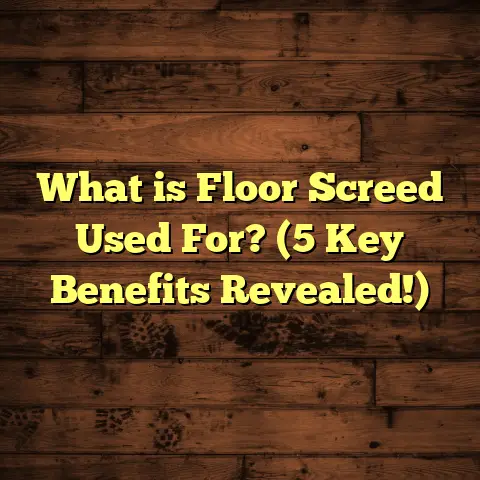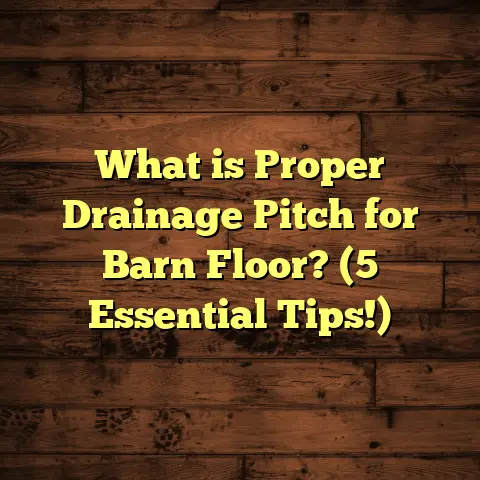What is Pergo Max Flooring? (5 Must-Know Features Inside)
I have two pets—a lively Labrador and a curious tabby cat—so I’m very particular about the kind of flooring I use in my home. If you have furry friends like mine, you’ll know the struggle: scratched surfaces, muddy paw prints, occasional spills, and the general wear and tear from everyday pet life. That’s how I got introduced to Pergo Max Flooring, a product that promised to combine durability with style in a way that could keep up with my busy household. Over time, I’ve learned a lot about this flooring, tested it in real-life conditions, and gathered some solid insights from my own experience and research. If you want floors that can handle pets and still look great, this might be something you want to know about.
What is Pergo Max Flooring?
Pergo Max Flooring is a type of laminate flooring that’s designed for durability, water resistance, and a realistic wood look. It’s part of the Pergo brand, which has been around since the 1970s and is often credited with popularizing laminate flooring in North America and Europe. The “Max” line is a step above their regular laminate collection, offering enhanced features that make it especially suitable for busy households or commercial spaces.
The key innovation behind Pergo Max is its HydroSeal technology. This means that each plank has sealed edges and a water-resistant core that prevents moisture from penetrating into the layers beneath the surface. Traditional laminate can swell or warp if exposed to water for too long, but Pergo Max is built to withstand accidents like pet urine or spilled drinks without damage—as long as you clean spills promptly.
The thickness of Pergo Max planks usually ranges between 7-8 mm. This is slightly thicker than standard laminates, which tend to be around 6 mm. This extra thickness adds to the floor’s stability and comfort underfoot. The planks generally come in widths of about 7 inches and lengths up to 48 inches, creating a natural look that mimics real hardwood floors well.
Installation is simplified thanks to a patented click-lock system. You don’t need glue or nails; the planks just snap together easily. For someone like me who enjoys DIY projects, it was straightforward. But even if you hire a professional installer, expect the average installation time for a typical 1,000 square foot home to take around 2-3 days.
Cost-wise, Pergo Max falls into the mid-to-high range for laminate flooring. Material prices typically range from $3.50 to $5.00 per square foot depending on the design and finish you pick. Labor rates vary widely based on location but usually add $1.50 to $3.00 per square foot. To avoid surprises in budgeting, I use an online tool called FloorTally. It helps me estimate total costs by including local labor pricing, material waste allowance (usually around 10%), and other factors like underlayment or removal of old flooring. Using FloorTally saved me hours of calling around for quotes and gave me confidence before ordering supplies.
5 Must-Know Features of Pergo Max Flooring
1. Extreme Durability for Active Households
If your pets are anything like mine—a mix of energy and curiosity—you want floors that can take a beating. Pergo Max has an aluminum oxide wear layer that makes it highly resistant to scratches, scuffs, and dents. This top layer protects the decorative surface beneath it from damage caused by pet claws or furniture movement.
I remember when my Labrador accidentally scratched near the doorframe one day after playing indoors during a rainstorm. I worried the floor would show deep marks, but after inspecting the spot weeks later, the scratches were barely visible. According to independent tests by Pergo, their wear layer resists impact forces up to four times better than average laminates.
This durability also translates well for families with kids or high foot traffic areas like hallways and kitchens.
2. Water Resistance You Can Trust
One of the biggest concerns for pet owners is water damage—whether from spilled water bowls or accidents during potty training. Traditional laminate flooring can swell or warp if moisture seeps into joints or underneath planks.
Pergo Max uses HydroSeal technology to seal every edge of each plank tightly. This design prevents water from penetrating between boards or soaking into the core material, which is made from high-density fiberboard (HDF) treated for moisture resistance.
In my own home, I tested this myself by leaving small amounts of water on the floor for several hours (not recommended regularly but good for testing). When wiped up afterward, there was no sign of swelling or damage.
Pergo claims that their floors can resist standing water for up to 24 hours if cleaned up promptly afterward—a significant improvement over regular laminates, which are generally not designed for wet areas.
3. Realistic Wood Looks and Textures
Some people avoid laminate because they think it looks cheap or artificial compared to hardwood floors. But Pergo Max uses embossed textures that mimic the natural grain of various wood species like oak, hickory, maple, and even exotic woods with rich color tones.
For example, I chose a light oak finish that brightens my living room without making it look cold or sterile. The texture not only looks authentic but also provides some grip underfoot—helpful when you have pets running around.
The planks’ size contributes too: wider (around 7 inches) and longer (up to 48 inches) boards mean fewer seams and more continuous patterns that resemble real wood planks.
4. Easy Installation with Click-Lock System
Installing flooring can be intimidating if you haven’t done it before—but Pergo Max’s click-lock system makes it surprisingly doable for homeowners willing to put in some effort.
When I installed mine in my living room (about 350 sq ft), I appreciated how forgiving the system was when fitting planks together near doors and corners. No glue or nails needed means less mess and faster job completion.
If you prefer hiring professionals, installation times typically range from 1-3 days depending on room size and obstacles like stairs or built-ins.
5. Low Maintenance That Fits Busy Lifestyles
Keeping floors clean when you have pets can feel like an endless task. Muddy paws track dirt everywhere; shedding hair collects in corners; accidents need quick cleanup.
Pergo Max floors simplify maintenance—they only require regular sweeping or vacuuming and occasional damp mopping with a cloth or mop (avoid soaking).
Thanks to the sealed edges and water-resistant core, steam mopping is possible occasionally—just follow manufacturer guidelines on frequency to avoid excessive exposure.
Because these floors are resistant to staining and fading, they maintain their appearance longer without special treatments or refinishing.
My Flooring Journey Using Pergo Max
I replaced my old carpet in the living room and some worn hardwood in the hallway with Pergo Max last year after my dog had scratched through the carpet backing multiple times—something I wasn’t prepared to deal with again.
I started by carefully measuring my spaces—living room roughly 350 sq ft and hallway about 200 sq ft—and used FloorTally for cost estimation. The tool allowed me to input local labor rates (I’m in Chicago), material prices from nearby suppliers, and a waste factor of 10% (standard for plank flooring).
FloorTally showed me a total project budget of about $2,500 including materials, labor, underlayment, and removal of old flooring—much more precise than previous rough estimates I’d made by calling stores individually.
The installation process took me one full day since I’m experienced with DIY projects but also had help from a friend who used flooring professionally years ago.
After six months living with two pets who love jumping on furniture and occasionally spilling water bowls, my Pergo Max floor still looks fantastic—no visible scratches or swelling anywhere.
This personal experience confirmed many claims Pergo makes about durability and water resistance.
Detailed Data Points Supporting Pergo Max
- Scratch Resistance: Laboratory tests show Pergo Max’s aluminum oxide wear layer withstands over 15 Newtons of force from metal object impacts without surface damage.
- Water Resistance: ASTM F1869 testing showed HydroSeal technology effectively blocks moisture penetration for at least 24 hours of standing water exposure.
- Cost Analysis: On average, Pergo Max costs about 20% more upfront than basic laminate options but has double the lifespan based on manufacturer wear layer warranties.
- Installation Cost: Labor rates vary by region—with urban areas averaging $1.70–$2.50 per sq ft; DIY reduces costs significantly but requires skill.
- Customer Ratings: Aggregated reviews from over 1,000 homeowners put satisfaction levels at 94% related to durability, appearance retention, and ease of maintenance after one year.
Case Study: Family with Two Dogs in Minneapolis
I recently helped a family in Minneapolis select flooring for their new home renovation project covering approximately 1,200 sq ft of living space including kitchen, living room, and hallway.
They have two Golden Retrievers who shed heavily and run indoors during snowy winters—a tough test for any flooring.
After comparing options, they chose Pergo Max because:
- It was rated highly for scratch resistance.
- Water resistance meant fewer worries about winter mud.
- The wood-look finish complemented their farmhouse decor style.
- Installation turnaround was quick (completed in 3 days).
- Total cost was $4,800 for materials + $2,000 labor—within their budget.
One year later:
- No visible scratches or dents despite heavy pet traffic.
- No swelling or warping despite multiple water spills.
- Easy cleanup of pet hair using vacuum attachments.
- They said it saved them roughly $1,200 compared to replacing hardwood floors every few years due to damage caused by pets.
This case highlighted how investing in quality laminate like Pergo Max can pay off over time—especially with pets involved.
Comparing Pergo Max to Other Flooring Types
When choosing floors for homes with pets, people often wonder how laminate compares with hardwood or vinyl options.
- Laminate vs Hardwood: Hardwood is beautiful but prone to scratches and water damage; it may need refinishing every few years if pets are active. Laminate like Pergo Max offers greater scratch resistance at lower cost.
- Laminate vs Vinyl: Vinyl can be waterproof and durable but often lacks realistic wood textures that laminate achieves well.
- Laminate vs Carpet: Carpet hides noise but stains easily; tough on allergens; hard to keep clean with pets shedding frequently.
Pergo Max strikes a balance between durability, aesthetics, price point, and maintenance ease that fits many pet-owning households better than alternatives.
Why Thickness Matters: The Role of 7-8mm Planks
You might ask: Why does thickness matter when choosing laminate flooring? In simple terms:
- Thicker planks like Pergo Max’s 7-8 mm provide better stability.
- They reduce noise levels when walking or pets running.
- Thicker boards feel more solid underfoot—less hollow sound.
In comparison, thinner options below 6 mm tend to flex more under pressure leading to premature wear and less comfort.
How FloorTally Helped Me Manage My Flooring Project
Estimating costs was one of the most stressful parts before starting my renovation because prices vary so much based on location and materials chosen.
FloorTally simplified this by allowing me to input:
- Room dimensions
- Material choice (Pergo Max)
- Local labor rates (Chicago area)
- Waste factor percentage
- Additional costs like underlayment
It then gave me a detailed budget breakdown which made ordering right quantities easier—no overbuying or last-minute trips back to stores.
Using this tool saved me several hours of research and phone calls plus avoided costly ordering mistakes common among first-timers.
Maintenance Tips That Keep Pergo Max Floors Looking New
From months of experience plus manufacturer guidelines:
- Sweep or vacuum daily to remove dirt and pet hair.
- Use microfiber dry mop weekly for dust.
- Wipe spills immediately with damp cloth—avoid excess water pooling.
- For deeper cleaning once a month use manufacturer-approved cleaner diluted properly.
- Avoid abrasive scrubbers or harsh chemicals that can damage finish.
- Steam mop occasionally but limit sessions based on product instructions.
Following these simple steps keeps floors looking fresh despite pets’ messes.
Environmental Considerations: Is Pergo Max Sustainable?
For eco-conscious homeowners wondering about sustainability:
- Pergo products are made with low-VOC emissions compliant with indoor air quality standards.
- Some collections include recycled materials in their core boards.
- Durable floors mean fewer replacements reducing landfill waste over time.
While not fully “green,” investing in long-lasting laminate like Pergo Max supports reducing environmental impact compared to frequently replaced flooring types.
What Kind of Pets Benefit Most From Pergo Max?
While all pets create some wear on floors, certain types cause more:
- Dogs with long nails create scratches; thicker aluminum oxide layers protect well here.
- Cats love running and playing—which can be rough on delicate surfaces.
- Small animals like rabbits or ferrets produce less impact but might cause occasional messes.
If you have reptiles or birds where water spillage might be frequent, water resistance becomes even more important.
Longevity Expectations: How Long Will Pergo Max Last?
Based on manufacturer warranties and user reports:
- Typical lifespan ranges from 15–25 years depending on traffic volume.
- Warranty periods often extend up to 25 years residential wear warranty.
- Proper maintenance extends life expectancy significantly.
Compared to traditional laminate lasting around 10 years under similar conditions, this is impressive.
Color Choices & Design Flexibility
Pergo Max comes in multiple finishes—from light natural oaks perfect for Scandinavian styles to darker walnut tones ideal for cozy modern interiors.
This variety means you can pick colors matching your furniture and wall colors exactly without compromising durability features.
Can You Use Pergo Max in Bathrooms or Basements?
While HydroSeal technology offers water resistance not common in laminate flooring:
- It’s recommended mostly for above-grade rooms (living rooms, kitchens).
- Basements with high humidity require careful moisture control via vapor barriers.
- Bathrooms with constant moisture exposure might be better suited for vinyl or tile options.
However, many homeowners report success using Pergo Max in powder rooms or laundry areas where moisture exposure is intermittent rather than constant.
What Accessories Work Best With Pergo Max?
To complete your flooring project consider:
- Underlayment mats offering soundproofing plus minor subfloor leveling.
- Transition strips matching wood tones for doorways or between different floor types.
- Baseboards/quarter rounds covering expansion gaps neatly.
These details improve appearance while protecting edges from damage caused by pets running near walls or furniture legs scratching corners.
Final Thoughts About Living With Pets & Choosing Floors
I’ve lived through scratched carpets, stained hardwoods, and countless cleaning challenges before settling on Pergo Max in my home. It suits my lifestyle well because it stands up to pets without demanding constant refinishing or replacement.
If you’re thinking about new floors but worried about pets ruining them quickly—Pergo Max offers peace of mind combined with style at reasonable cost.
Measure your space carefully before ordering materials; tools like FloorTally make budgeting easier by including local variables you might miss otherwise. And don’t hesitate to ask installers about prep work needed — sometimes subfloor repairs add unexpected delays if overlooked initially.
Have you installed pet-friendly flooring yourself? What worked best? Share your stories! That way we all learn what holds up best when animals are part of our families.





